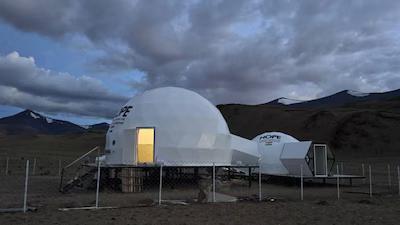
ISRO Sets Up Station in Ladakh to Simulate Life on Moon & Mars
In a significant step towards exploring the vast expanse of space, the Indian Space Research Organisation (ISRO) has set up a unique station in Ladakh’s Tso Kar Valley to simulate life on the Moon and Mars. Dubbed the Himalayan Outpost for Planetary Exploration (HOPE), this facility is designed to test life-support systems for lunar and Martian missions. The valley was chosen for its extreme conditions, which bear a striking resemblance to those found on the Red Planet.
Located at an altitude of 15,000 feet, the Tso Kar Valley is known for its high UV radiation, low atmospheric pressure, extreme cold, and saline permafrost. These conditions are eerily similar to those found on Mars, making it an ideal location for ISRO to test its equipment and strategies for future missions.
The HOPE station is equipped with state-of-the-art technology and equipment, designed to simulate the harsh environment of space. The facility will be used to test various aspects of life support systems, including food, water, air, and waste management. The team will also conduct experiments to study the effects of radiation on living organisms.
The tests at HOPE will be conducted by two crew members who will undertake various experiments and simulations for a period of 10 days, starting from August 1. The crew will be responsible for maintaining the facility, conducting experiments, and collecting data. This simulation mission will help ISRO to identify and rectify any issues that may arise during future missions to the Moon and Mars.
The Tso Kar Valley was chosen for the HOPE station due to its unique combination of extreme conditions. The high UV radiation and low atmospheric pressure are similar to those found on Mars, while the extreme cold and saline permafrost provide a challenging environment for the crew to operate in. The valley’s remote location also makes it an ideal spot for conducting experiments without any external interference.
ISRO’s HOPE station is a significant step towards the country’s ambitious plans to explore space. The organisation has been working towards establishing a human settlement on the Moon and Mars, and this facility will play a crucial role in testing the technology and strategies required for such missions.
In an interview with News18, ISRO scientist Dr. Suresh Kumar said, “The HOPE station is a critical component of our plan to send humans to the Moon and Mars. We will be testing various aspects of life support systems, including food, water, air, and waste management. The data collected during this simulation mission will help us to identify and rectify any issues that may arise during future missions.”
The HOPE station is a testament to ISRO’s commitment to exploring space and pushing the boundaries of human knowledge. The organisation has made significant strides in recent years, including the successful launch of the Chandrayaan-1 mission to the Moon and the Mangalyaan mission to Mars.
As the world continues to explore the vast expanse of space, ISRO’s HOPE station in Ladakh’s Tso Kar Valley is an important step towards making human settlements on the Moon and Mars a reality. The data collected during this simulation mission will be crucial in helping ISRO to overcome the challenges of space travel and establishing a human presence on other planets.
News Source:






